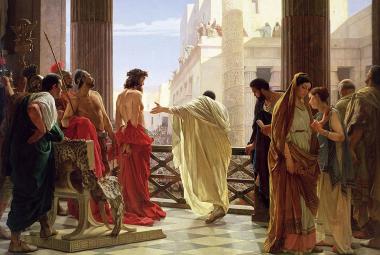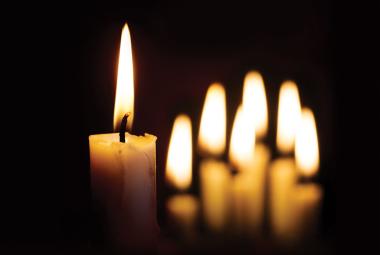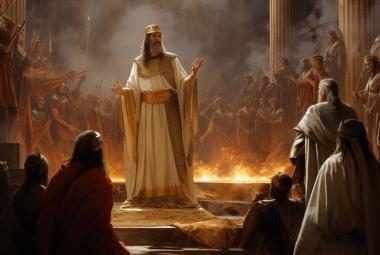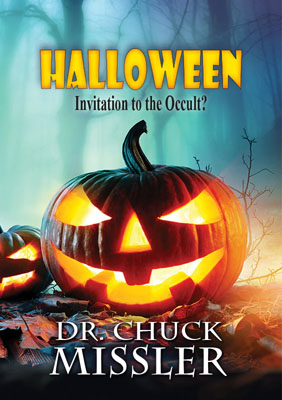Later this month, hordes of costumed children will be hitting the streets in search of candy and other treats. Yet, Halloween is not just “trick or treat” and “fun and games.” Halloween practices can open the door to the occult and can introduce forces into people’s lives that they are not equipped to combat.
The lure of the occult has affected mankind throughout the ages. According to the Greek legend, Pandora, despite warnings by Zeus not to, yielded to her curiosity and opened the forbidden box and thus inadvertently released all manner of evils which flew out to cover the Earth.
The occult takes many forms; oftentimes it appears very desirable. In Homer’s Odyssey, Ulysses had himself lashed to the mast to preclude his succumbing to the alluring call of the Sirens.
It’s crucial to lash ourselves to the mast of known truth and prepare to pass through turbulent waters that have “bested the best” of the mariners of the past.
Mysticism
The boundaries are not clearly defined which separate mysticism from metaphysics (basic nature or structure of being), cosmology (study of the origin of the universe), theosophies (systems of conjectures into the divine nature), and occultism (the study and control of supernatural powers), theurgy (the art of compelling or persuading supernatural powers) and magic (often of the lowest kind).
Each of these, unless securely lashed to the tether of the revealed Word of God, ultimately ends up in direct conflict with the Biblical record.
Non-Biblical mysticism is always essentially incompatible with the teachings of Judaism and Christianity, which promote a faith in a sole God who created the universe and who chose to reveal Himself and communicate the rules of life through an exclusive relationship with Him.
Clearly, John and Paul were mystics in the sense that our union with Christ was their highest desire, but their aspirations and pursuits were always within the safeguards of Scripture.
Extra-Biblical speculations on the origin and order of the universe, influenced by correspondences in ancient and medieval science, led to mysticism in various forms, including the Kabbalah of Judaism and the Gnostic heresies of Christianity, each increasingly divergent from its foundational source.
Mysticism invariably ends up contradicting or contravening the Biblical record.
The Rise of Jewish Mysticism
Judaism, while traditionally having relied on the substitutionary sacrifices of the Torah, but then stripped of both a Messiah and the Temple, gradually evolved to become a program of ethical and moral efforts of the Jews to acquit themselves before God.
Constant ideological readjustment involved the infiltration of concepts from external sources, including Babylonian and Greek mysticism, and the reactions against them.
The Talmud and the Midrash (rabbinical legal and interpretative literature) tended to obliterate the earlier traditions as the veneration of various sages and commentators tended to eclipse the primary texts of the Tanakh (the Old Testament) itself.
Interpretive exegesis and the veneration of con-temporary sages opened up increasing opportunities for matters of inner experience and personal speculations.
The Kabbalah
The Kabbalah (hlbq, from lbq,, “to receive”; literally, “the received lore,” or “tradition”) is a term used several ways. Originally it comprised the entire traditional lore, in contradistinction to the written law (the Torah), and therefore included the prophetic and hagiographic books of the Bible, as “received” by the power of the Holy Spirit.
From the 13th century onward, the Kabbalah branched out to include extensive esoteric Jewish speculations alongside of, and ultimately in opposition to, the Talmud.
It grew to include esoteric or mystic doctrine, asserting to have come down as a revelation to elect saints, preserved for a privileged few.
An eclectic amalgam of pantheism and other Eastern pagan concepts, the Kabbalah endorses a non-Biblical view of God. The God of the Old Testament is inferior to the supreme unknowable Ein Hof, the ulti-mate focus of Kabbalahism. With practices parallel with Indian (Tantric kundalini) yoga and Muslim sufism, one of the goals is the manipulation of the divine nature.
With the rise of interest in the occult today, the resurgence of interest in the Kabbalah is no exception.1 (For further study, see our briefing package, Kabbalah.)
Christian Mysticism
The role played by the Kabbalah was not limited to the Jewish community. The Kabbalah transcended the frontiers of Judaism and influenced Christian mysticism from the Renaissance to the present. Under the influence of Jewish converts from Spain and Italy, Kabbalistic documents, touched up as necessary (or even forged), provided arguments supporting Christian doctrinal issues or deviations.
The occult philosophy of the 16th century, the “natural philosophy” of the 17th and 18th centuries, and the occult and theosophic theories today—including the practices of Freemasonry—borrow from the amalgam of the Kabbalah.
Biblical Warnings Against the Occult
The occult is on the rise in all segments of our society. There is great power in the occult.2 However, the Bible warns against it.3
There were many superstitions and false concepts in ancient Israel about which the Bible is silent. However, occultism, in any form, was punishable by death! Why?
Occult practice constitutes trafficking with demons, from which flow other concerns: idolatry, spiritual deception, the likelihood of possession, psychological, spiritual and physical harm, and immoral teachings.
The Bible commands us to shun occult practices. Mediums and spiritists are expressly prohibited.4 No-where are such practices acceptable.
Spiritual warfare is a reality.5 We have serious enemies that are extremely resourceful and malevolent. The Bible warns of a personal devil and myriads of demons who should be regarded as cunning enemies.6
Satan and his hordes are active in the affairs of Planet Earth.7 In fact, the whole world lies in the power of the Evil One,8 and his forces are behind all occult involvement, idolatry, and false religion.9 All supernatural manifestations are to be tested by the Word of God.10 The devil’s tactics include masquerading as an “angel of light” and a servant of righteousness.11 False teachers and false prophets are linked to evil spirits, and there are “doctrines of demons.”12 Demons work through people by giving them psychic abilities.13
The Dark Side of Halloween
Halloween is, for many, a “crossover” involvement in which innocent games can lead to serious entanglement with real witches, neopagans, New Agers, and other occultists.14
A common pastime is the use of a Ouija board to at-tempt to contact ghosts or spirits that are believed to be roaming about. This can lead to serious consequences, including demon possession.15 Demons have a vested interest in Halloween because it supports the occult, and it also offers novel and unexpected opportunities to control and influence people.
Forms of the occult can include mediums, channelers, clairvoyants, psychics, spiritists, diviners, mystics, gurus, psychic and holistic healers, astral travel, astrology, mysticism, Ouija boards, Tarot cards, contact with the dead, UFOs, and thousands of other practices which almost defy cataloging—even Harry Potter books and movies can lead innocent children into the occult.
Occultism also includes Satanism, Kabbalah, Gnosticism, theosophy, witchcraft and many forms of serious magic. It includes activities seeking the acquisition of “hidden” things—which are expressly forbidden by God in the Bible.
Your Protection
Intellect alone is insufficient. “If it were possible, it would deceive the very elect.”
This is another example of the necessity to truly understand the Armor of God as outlined in Ephesians 6.
To learn more about the dark side of Halloween, see our classic briefing package, Halloween: Invitation to the Occult?, available from our store.
Notes:
- “What Profits the Kabbalah,” Time,November 24, 1997.
- Isaiah 47:9.
- Deut 18:9-14.
- Lev 19:31; 2 Chr 33:6.
- Eph 6:10-18; 2 Cor 2:11; 1 Pet 5:8.
- Jn 8:44; 13:27; Mt 6:13; 9:34; 12:24; Lk 8:12; 13:16; 2 Cor 4:4; Col1:13; 2 Thess 2:9; Acts 16:16-18; 2 Cor 2:11, 11:3; 2 Tim 2:26.
- Eph 2: 2 ; Dan 10:12,13, 20.
- 2 Cori 4:4; 1 Jn 5:19.
- Deut 32:16, 17; 1 Cor 10:19-21; Ps 106:35-40; 1 Tim 4:1; 2 Thess 2:9, 10; Acts 16:16-19, et al.
- 1 Jn 4:1; Rev 2:2; Acts 17:10-12; Deut 18:20-22; Mt 24:24, etc.
- 2 Cor 11:13-15.
- 1 Tim 4:1; 1 Jn 4:1.
- Acts 16:16-19; Ex 7:11, 22; 8:7.
- See Encyclopedia of New Age Beliefs, Harvest House, Eugene OR, 1996.
- The case studies underlying William Blatty’s The Exorcist indicate that the trouble all began with a child playing with a Ouija board.







